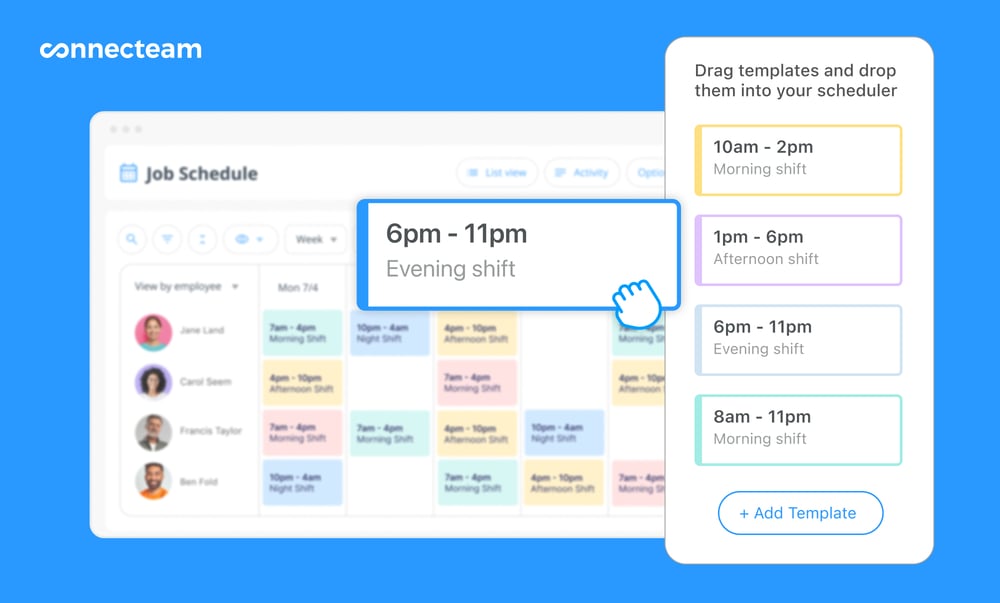Most people are familiar with the traditional 9-5 working hours, but shift work involves nontraditional hours that may even go through the night. This type of scheduling is essential for businesses that operate around the clock or have fluctuating demands.
Understanding shift work can help you optimize employee scheduling, ensuring efficiency and employee satisfaction in your business.
Key Takeaways
- Shift work includes schedules outside the standard 9-5, such as evening, night, rotating, and split shifts. Each type caters to different industry needs and business requirements.
- While shift work can offer flexibility and sometimes higher pay, it can disrupt sleep patterns and impact overall health.
- Shift work offers several advantages, such as scheduling flexibility, higher pay for less desirable hours, reduced commute times, and potential career advancement.
- However, it also has drawbacks, including disrupted sleep schedules, poor work-life balance, safety concerns, and the potential for lower employee morale.
What is Shift Work?
Shift work is a type of scheduling for businesses that operate outside of the standard 9-5 working hours. 16% of US employees work for companies that utilize shift scheduling, which may occur at any time of day or night. Workers are usually paid hourly instead of receiving a flat salary.
Imagine a factory running 24/7. To keep business running smoothly, the manager utilizes rotating shifts where different teams cover various blocks of time. This can include evenings, nights, early mornings, or a combination.
While shift work offers flexibility and sometimes higher pay, it can disrupt sleep patterns and impact health. Businesses with shift workers need clear communication and support systems to promote employee well-being despite the non-traditional hours.
Types of Shift Work
There are many different types of shift schedules that can apply to both part-time and full-time employees. Let’s explore some of the different options, as well as which industries most commonly use shift schedules:
First, second, and third shifts
Businesses that operate 24 hours may utilize this type of shift schedule to make sure all hours are covered. Here’s a breakdown of each shift type:
- First shift: Also known as the day shift, first shift starts in the morning and ends in the afternoon (ex. 8:00 am-4:00 pm).
- Second shift: Second shift usually starts in the late afternoon and ends at night (ex. 4:00 pm-12:00 am).
- Third shift: Commonly referred to as the night shift or the graveyard shift, the third shift starts late at night and ends in the early morning (e.g., 12:00 a.m.- 8:00 a.m.).
Industries that may use this type of shift schedule: Hospitals and urgent care, manufacturing, emergency services, security, hotels, hospitality.
Pro Tip
Investing in employee wellness can lead to higher rates of retention and productivity.
Here are some effective strategies to boost the morale of third-shift workers who may struggle with working through the night:
- Encourage them to sleep during the day. Provide eye masks to block out light and ear plugs to reduce daytime noise.
- Provide food and drinks. If you have multiple staff working in the same location, provide quality food and drinks so they don’t go hungry.
- Conduct regular check-ins: Have managers regularly check in with night shift staff to provide support, gather feedback, and share company updates.
- Implement a recognition program: Create an awards and recognition program that highlights the contributions of night shift workers equally with those of day shift workers. Make sure achievements are recognized company-wide.
- Healthy Nightshift Scheduling: Create the best possible nightshift schedule for your employees to stay healthy.
Split shifts
Split shifts divide working hours into separate blocks of time on the same day, typically with a break of several hours between each shift.
For example, a restaurant server might work the breakfast shift from 8:00 a.m. to 11:00 a.m. and then also work the dinner shift from 5:00 p.m. to 10:00 p.m. This way, the server gets a full 8 hours of work but gets the chance to rest between shifts.
Industries that may use split shift: Restaurants and food service, retail, non-urgent healthcare facilities, public transportation, salons and spas.
Rotating shifts
Rotating shifts involve a work schedule where employees alternate between different shift times, such as morning, afternoon, and night, over a set period. This rotation can be weekly, bi-weekly, or on any other recurring basis. The main purpose of rotating shifts is to distribute the burden of less desirable shift times, like nights and weekends, more evenly among all employees.
The rotation pattern can be fixed, such as every week or every month, or vary depending on business needs and job types. While rotating shifts change, they are usually predictable, allowing employees to plan their personal lives around their work schedules in advance.
Industries that may use rotating shifts: Hospitals, manufacturing, utilities such as powerplants and water treatment facilities, emergency services.
Swing shifts
Swing shifts fall outside the traditional day and night shift hours and are used to ensure round-the-clock coverage. They’re commonly used to help cover peak hours, often called “rushes,” when there’s a greater demand on the business.
While any type of business may use swing shifts, they’re more common for businesses that are open 24 hours or provide services outside of standard working hours.
Industries that may use swing shifts: Convenience stores, call centers, military and security, healthcare, hospitality, public safety, emergency services.
Double shifts
A double shift is when an employee works two shifts in a row to cover for absences or increased business demand. While double shifts can be grueling, some industries rely on them to meet deadlines or cover peak business hours.
While double shifts offer extra pay, they can also lead to fatigue, burnout, and excessive overtime. Employers should ensure employees on doubles have breaks and plan schedules carefully.
Industries that may use double shifts: Bars and restaurants, retail, manufacturing and production, healthcare, emergency services, security.
Flexible shifts
Flexible shifts allow employees to vary their arrival and departure times and sometimes even choose the days they work. This type of scheduling is designed to accommodate personal needs and preferences, which can help improve work-life balance and employee productivity.
Industries that may use flexible shifts: Technology and IT, creative industries such as design and media, education and training, and consulting.
On-call shifts
Employers may create on-call schedules to ensure coverage during busy shifts or to cover for absences. Employees aren’t required to come in to work unless their manager calls them in.
Industries that may use on-call shifts: IT, healthcare, restaurants and hospitality, event venues, aviation, trucking, police officers and paramedics.
Fixed shifts
Fixed shifts, also known as fixed schedules, are when employees consistently work the same hours and days without any variation.
This type of schedule can apply to any shift, such as morning, afternoon, or night, and remains constant over time. It’s also commonly used in businesses where consistent coverage and routine are important.
Fixed shifts are suitable for all business types. Whether or not this type of schedule will work for your business depends on what type of company you have and employee preference.
Did You Know?
Scheduling is fluid, and shift and schedule types can overlap.
Here’s an example: A customer service call center implements flexible shifts on a rotating schedule. Employees are required to work a core block of 8 hours, but they can choose when to work between 10:00 a.m. and 8:00 p.m.
The call center rotates the number of required hours every week to ensure everyone shares the peak workload. Overlaps during high call volume periods guarantee coverage and keep the call center running 24/7. Flexible shifts give employees some control over their schedules while rotating core hours ensures fairness and prevents burnout.
Pros and Cons of Shift Work
The pros and cons of shift work vary depending on the industry and type of business. Let’s go over some of the key advantages and disadvantages:
Pros of shift work
- Flexibility: Shift work can offer scheduling flexibility, allowing employees to work evenings, nights, or weekends while having weekdays free.
- Higher pay: Some shift work schedules, especially night or weekend shifts, offer premium pay or differential wages as an incentive for filling less desirable hours.
- Reduced commute: Early morning or late-night shifts can allow for commutes during off-peak hours, reducing travel time.
- Career advancement: In some industries, working nights or weekends can be a stepping stone to more senior positions that require extended hours or leadership experience.
Cons of shift work
- Sleep schedule disruptions: Shift work can disrupt sleep patterns and natural circadian rhythms, potentially leading to fatigue, insomnia, and increased risk of health problems like obesity or diabetes.
- Poor work-life balance: Working non-traditional hours can make it difficult for staff to maintain a healthy work-life balance and participate in social activities or family events.
- Safety concerns: Commuting late at night or in the early morning hours can pose safety risks, especially for employees who travel alone.
- Lower morale: The constant adjustment to changing sleep patterns and missing out on social activities can contribute to lower employee morale and decreased motivation.
This Might Interest You
Check out our complete article on how to make the perfect work schedule for your team.
Read more about different kinds of standard schedules such as 2-2-3 schedule (Panama schedule), Dupont schedule and Pitman schedule.
Ready to streamline shift scheduling? Check out our in-depth review of the top free employee scheduling software to find the right fit for your team’s needs.
Create Seamless Shift Schedules With the Right Software
While scheduling may seem complex, it doesn’t need to be. Using the right software, you can create shift schedules in a fraction of the time.
Connecteam is an award-winning employee scheduling app that provides all the tools you need to create and manage team schedules with complete ease and efficiency, even while on the go.
The software also comes with a GPS-enabled employee time clock so staff can clock in and out right from their phones and integrations with leading payroll software including Quickbooks, Gusto, Paychex, and Xero.
Here are a few of Connecteam’s key features to help you streamline the shift scheduling process:
- Drag-and-drop shift scheduler: Create customized schedules using shift templates to speed up the process. The app will also flag you if you accidentally create any errors, such as double scheduling or scheduling an employee who’s on vacation.
- Auto-scheduling: Predefine how many staff and which roles you need per shift, and the auto-scheduler will create the schedule for you, taking into consideration employee availability, preferences, skill sets, and business needs.
- Digital shift swapping: Employees can request shift swaps directly from the Connecteam app, and you can approve or deny them. Once you approve a shift swap, the app will automatically update the schedule and send push notifications to anyone whose hours or days have changed.
- Break and overtime management: Connecteam automatically alerts employees when they need to take a break. You can also set the app to automatically notify you when an employee approaches overtime. That way, you can better manage overtime pay, reduce the amount you spend on payroll, and ensure compliance with labor laws.
Teams of up to 10 people can get Connecteam’s employee scheduling software free for life, and the platform’s paid plan starts at just $29/month for up to 30 users.
>> Get started with Connecteam for free today! <<
This Might Interest You
Download our free templates to streamline business workflows:






